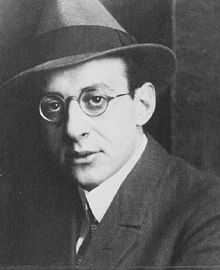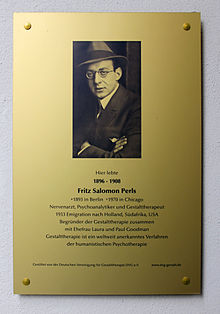Fritz Perls
Friedrich Salomon "Fritz" Perls - also Frederick S. Perls - (* July 8, 1893 in Berlin ; † May 14, 1970 in Chicago ) was a psychiatrist and psychotherapist of German-Jewish origin. Together with Laura Perls and Paul Goodman , Fritz Perls is a co-founder of Gestalt therapy .
Life
After graduating from high school, Perls began studying medicine at the Askanisches Gymnasium in 1914. During the First World War he served as a field doctor . During his studies Perls played at the expressionist theater with Max Reinhardt and shared his demand for truth and authenticity in contrast to “that empty acting that life is full of”. In 1921 Perls was promoted to Dr. med. doctorate, followed by psychoanalytic training. After a short stay in the USA, Perls began psychoanalysis with Karen Horney .
From 1926 Perls worked as an assistant doctor with Kurt Goldstein . Together they carried out studies on brain injured people. Goldstein introduced Perls to Gestalt psychology , which was to have a major influence on the development of Gestalt therapy. During this time he met Lore Posner, a Goldstein student. In 1930 Fritz Perls and Laura Perls married .
In 1927 Fritz Perls met Wilhelm Reich in Vienna and took part in his “technical seminars”. Later, in 1930, when Reich had settled in Berlin, he completed a training analysis with him that lasted about two years , which was broken off in January 1933 because they both emigrated. As his wife Lore / Laura reports, Perls was “absolutely fascinated by Reich.” Of the four therapists Perls had, he was “by far the best”. Reich's concept of character analysis found Perls' particular interest and later influenced the development and shaping of Gestalt therapy.
South Africa
In April 1933, after the National Socialist seizure of power , the Perls family fled first to the Netherlands, to Amsterdam, and then, in 1934, to South Africa. Fritz and Laura Perls founded the South African Institute for Psychoanalysis there . In 1936 Fritz Perls gave his first lecture entitled Oral Resistance at a psychoanalytic congress in Czechoslovakia . This met with skepticism from most psychoanalysts, as the prevailing doctrine was that resistance is always anal. There was a first break with the orthodox psychoanalysts: “ It was rejected: 'Resistances are always anal' (!) I was resentful. This was my first break with the orthodox ones. ”
The congress was followed by Perls' first and only visit to Sigmund Freud in Vienna; this turned into another big disappointment. The meeting lasted only about five minutes and consisted only of a few polite phrases.
In 1941 Fritz Perls and his wife Laura wrote his first book Das Ich, der Hunger und die Aggression , which already describes the basic theoretical ideas of Gestalt therapy and already outlined the main program of the book in the subtitle of the first publications (1944/1947): A revision of Freud's theory and method . The book also represented the beginning of Gestalt therapy, even if this term did not appear here.
In 1942 Perls joined the army. In 1946 he was released and emigrated to the USA.
USA and Canada
Perls developed - in contrast to psychoanalysis - with his wife Laura Perls and with the collaboration of Paul Goodman , the Gestalt therapy . It is a specific experience-activating psychotherapy procedure that aims to promote awareness , the awareness of all present feelings, sensations and behavior, and the contact with oneself and the environment.
In 1951 the book Gestalt Therapy appeared , which he had written together with Paul Goodman and Ralph F. Hefferline . In 1952 Fritz and Laura Perls founded the Gestalt Institute in New York. In 1953 another foundation followed in Cleveland. Perls developed a typical experimental way of working that quickly found supporters. His contacts included Judith Malina and Julian Beck , who developed the Living Theater from working with Erwin Piscator .
From 1960 Perls dealt with existential psychiatry and studied Zen in Japan . In 1964 he went to the Esalen Institute in Big Sur , California , a meeting place for the human potential movement in the 1960s. It was here that Perls conducted his Gestalt workshops with aspiring psychotherapists. Through the collaboration with Steve Andreas , the owner of the Real People Press publishing house , and his publication of the book Gestalt Therapy Verbatim in 1968, Gestalt therapy became generally known in the USA. In 1969 Perls founded a Gestalt community at Lake Cowichan on Vancouver Island , Canada .
In 1970 Perls died in Chicago while on a lecture tour. The couple's grave is in the Jewish cemetery in Pforzheim .
Honor
In August 2001 the asteroid (23111) Fritzperls, discovered on January 2, 2000, was named after him.
position
Perls remained true to his origins in psychoanalysis, despite strong criticism of it, insofar as his Gestalt therapy, like psychoanalysis, is essentially resistance analysis: Gestalt therapy is about the analysis and working through the various resistances, contact, insight and change oppose.
Perls was strongly influenced by Gestalt psychology and Gestalt theory , with which he shared the holistic orientation and from which he integrated some findings into his Gestalt therapy. These references are also expressed in the choice of the term gestalt therapy. The American gestalt psychologists Rudolf Arnheim , Mary Henle , Michael Wertheimer and others, however, were critical of this relationship.
"Perls' interest in the character of man in contrast to his symptoms is primarily due to Wilhelm Reich ."
He also implemented his own theater experiences in his work with therapy groups: like a director, he accompanies the people to stage and present their inner drama, dreams and opposites in the group in order to accept and understand them themselves.
Publications
- 1942: Ego, hunger and aggression. The beginning of Gestalt therapy.
- German edition: The ego, hunger and aggression. The beginnings of Gestalt therapy. 1969
- 1951: Gestalt therapy: Excitement and growth in the human personality. Together with Ralph F. Hefferline and Paul Goodman.
- German edition: Gestalt therapy. Joie de vivre and personality development. 1979
- 1969a: Gestalt Therapy Verbatim. Real People Press, Lafayette
- German edition: Gestalt therapy in action. 1974; 9th edition: Klett-Cotta, Stuttgart 2002, ISBN 3-608-95984-X
- 1969b: In and out the garbage pail. Autobiography. Real People Press, Lafayette
- German edition: Gestalt perception. Discarded and found things from my garbage can. The unusual autobiography of the founder of Gestalt therapy. 1981
- 1973: The Gestalt Approach & Eye Witness to Therapy. Science and Behavior Books, Palo Alto
- German edition. Basics of Gestalt therapy. Introduction and minutes of meetings. Translated from American English by Monika Ross. With a foreword by Hilarion Petzold . Pfeiffer, Munich 1976, ISBN 3-7904-0172-2
- 1980: shape, growth, integration. Essays, lectures, therapy sessions. Edited by Hilarion Petzold.
Others
The painter Otto Dix made a painting by Fritz Perls in 1966. This can be seen in the Otto-Dix-Haus in Gera .
literature
- Bernd Bocian: Life Experience and Theory Production, Fritz Perls in Berlin 1893-1933. A contribution to German prehistory and at the same time to the topicality of gestalt therapy and gestalt pedagogy. Technical University, Berlin 2002 (Diss.), DNB 966410556 .
- Bernd Bocian: Fritz Perls in Berlin, 1893–1933: Expressionism, psychoanalysis, Judaism. Peter Hammer Verlag, Wuppertal 2007, ISBN 978-3-7795-0086-5 .
- Petruska Clarkson, Jennifer Mackewn: Frederick S. Perls and Gestalt Therapy. EHP, Cologne 1995, ISBN 3-926176-52-0 .
- Martin Shepard: Fritz. An Intimate Portrait of Fritz Perls and Gestalt Therapy. Saturday Review Press, New York 1975, ISBN 978-0-8415-0354-0 .
Web links
Individual evidence
- ^ Fritz Perls: Basics of Gestalt Therapy. Introduction and minutes of meetings. Pfeiffer, Munich 1976, p. 4.
- ↑ Bernd Bocian: Fritz Perls in Berlin, 1893-1933: Expressionism, psychoanalysis, Judaism. Peter Hammer Verlag, Wuppertal 2007, p. 206.
- ↑ Laura Perls: Interview 1984 with Daniel Rosenblatt. In: Gestalt criticism. Zeitschrift für Gestalttherapie, No. 1/2008, pp. 10-17.
- ↑ Bernd Bocian: Fritz Perls in Berlin, 1893-1933: Expressionism, psychoanalysis, Judaism. Peter Hammer Verlag, Wuppertal 2007, p. 249.
- ↑ Bernd Bocian: Fritz Perls in Berlin, 1893-1933: Expressionism, psychoanalysis, Judaism. Peter Hammer Verlag, Wuppertal 2007, p. 293.
- ↑ So quoted by Perls himself. ( Memento of the original from October 31, 2011 in the Internet Archive ) Info: The archive link was inserted automatically and has not yet been checked. Please check the original and archive link according to the instructions and then remove this notice.
- ↑ M. Sreckovic: History and Development of Gestalt Therapy. In: Fuhr / Sreckovic / Gremmler-Fuhr (ed.): Handbook of Gestalt therapy. Hogrefe Verlag, Göttingen 1999, pp. 15–178, here: p. 101.
- ↑ M. Sreckovic: History and Development of Gestalt Therapy. In: Fuhr / Sreckovic / Gremmler-Fuhr (ed.): Handbook of Gestalt therapy. Hogrefe Verlag, Göttingen 1999, pp. 15–178, here: p. 107.
- ↑ Minor Planet Circ. 43194 (PDF)
- ^ Gerhard Stemberger : Gestalt theoretical criticism of conceptions of Gestalt therapy. Bibliography 1974-2010 . In: Phenomenal - Journal for Gestalt Theoretical Psychotherapy , 2 (1), 2010, pp. 51–53.
- ^ Reference painting by Fritz Perl
| personal data | |
|---|---|
| SURNAME | Perls, Fritz |
| ALTERNATIVE NAMES | Perls, Friedrich Salomon; Perls, Frederick S. |
| BRIEF DESCRIPTION | Psychiatrist and psychotherapist |
| DATE OF BIRTH | July 8, 1893 |
| PLACE OF BIRTH | Berlin |
| DATE OF DEATH | May 14, 1970 |
| Place of death | Chicago |

